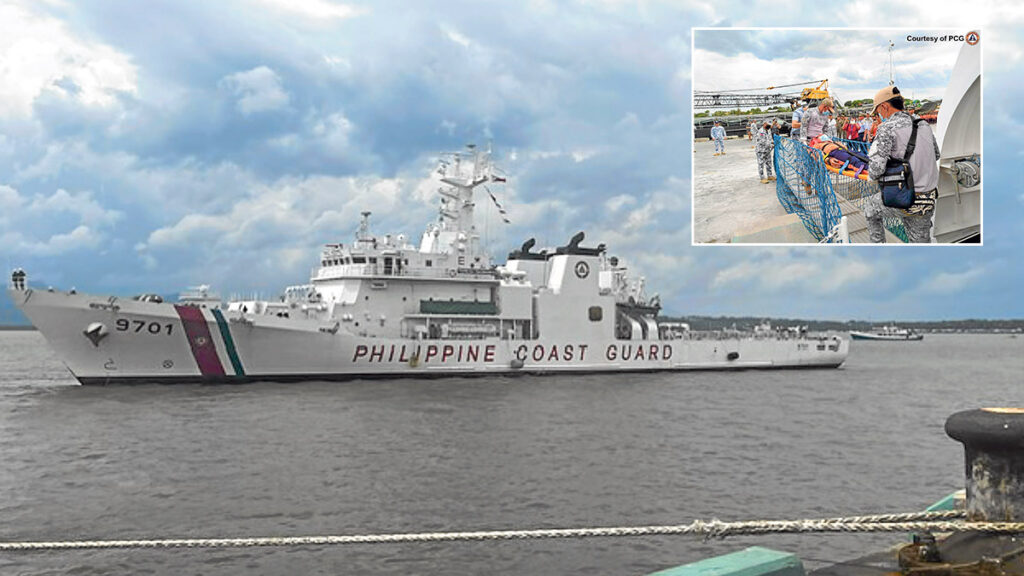
SACRIFICE AT SEA The BRP Teresa Magbanua docks at Puerto Princesa City, provincial capital of Palawan, after five months of patrolling Escoda (Sabina) Shoal, with some of its dehydrated crew members given medical attention upon the vessel’s return. —Frances Mangosing and PCG
MANILA, Philippines — The departure of BRP Teresa Magbanua to Escoda (Sabina) Shoal is “entirely different” from the 2012 incident in Panatag (Scarborough) Shoal which led to China’s effective control of the sandbank’s lagoon.
The Philippine Coast Guard (PCG) and a security expert rejected the comparison of these two incidents, saying there are several key differences between their circumstances.
“This is entirely different and again as far as the Philippine Coast Guard is concerned, we have not lost anything,”
Philippine Coast Guard spokesperson Commodore Jay Tarriela said in a press conference on Monday.
Security expert Chester Cabalza also shared the same observation: “The 2012 Scarborough Shoal standoff differs from the 2024 Sabina Shoal conundrum in terms of geography and strategic value.”
Article continues after this advertisement
In 2012, Manila and Beijing had a tense standoff over Panatag Shoal, with the former withdrawing its ships from the shoal that led to the latter having an effective control of its lagoon to date. A year later, Manila lodged an arbitration case against Beijing after the 2012 standoff which led to a historic 2016 arbitral award that effectively rejected the latter’s sweeping claims in the West Philippine Sea.
Article continues after this advertisement
READ: China ships stay in Panatag Shoal
A parallel of the 2012 standoff was drawn after the return of the largest PCG ship in Puerto Princesa port in Palawan on Sunday after being deployed there for five months.
READ: ‘Lugaw’ and rainwater for weeks: BRP Teresa Magbanua crew’s struggles in WPS
Different features
Tarriela and Cabalza both noted a key difference such as their features.
“Bajo de Masinloc only has one single entrance, and that is the southeast entrance of the lagoon in Bajo de Masinloc,” Tarriela said. “Escoda Shoal is composed of two lagoons on the west side and eastern side and each lagoon has different areas where you can pass through.”
Cabalza, president and founder of Manila-based think tank International Development and Security Cooperation further noted that “Escoda Shoal has multi-entry sea lanes compared to the enclosed and one-mouthed Scarborough Shoal which can be easily controlled by China.”
Thus, Tarriela said it would be “almost impossible” for Beijing to prevent the patrol of Manila.
“Escoda Shoal, no matter how many instances we intend to go there, we will be able to patrol and deploy our vessel,” he said.
Very large
Tarriela further noted: “We can go to Escoda Shoal with such total area and it’s almost impossible for the Chinese government to block our intent to patrol the entire vicinity of Escoda Shoal.”
“I believe the Philippine Coast Guard intends to continue patrolling around Escoda Shoal, and that it is well aware that its patrols may continue to be aggressively challenged despite the departure of the BRP Teresa Magbanua,” said West Philippine Sea monitor Ray Powell in a message to INQUIRER.net on Monday.
While Escoda Shoal is indeed “very large”, Powell, program head of Stanford University’s Gordian knot Center for National Security Innovation which monitors Chinese vessels activity in South China Sea, noted that China has a considerable presence near the shoal.
“Escoda Shoal is indeed very large and difficult to patrol,” Powell said. “On the other hand, China does have a very large fleet of ships in the area—including those at the nearby Mischief Reef military base.”
Escoda Shoal and Panatag are quite close when it comes to its total area at 137 square kilometers and 150 square kilometers, respectively.
Fighting spirit
Also, Escoda Shoal serves as the rendezvous point for Filipino vessels carrying out resupply missions to the naval outpost in Ayungin Shoal, where the naval outpost BRP Sierra Madre, which is a main flashpoint of tensions between Manila and Beijing, is aground since 1999.
Chinese state publication Global Times once claimed that BRP Teresa Magbanua is “semi-grounded” in the shoal, similar to what it said the country did with the BRP Sierra Madre.
“China feared that the Philippines would replicate its strategic success by grounding an active coast guard vessel to man and protect the atoll closest to Palawan,” Cabalza said.
Due to what Tarriela deemed as China Coast Guard’s “targeted harassment”, supplies for BRP Teresa Magbanua became critical in August.
On Aug. 19, PCG’s 44-meter vessels BRP Cape Engaño and BRP Bacagay were subjected by CCG to what the PCG deem as aggressive maneuvers while traversing the waters off the shoal, damaging both ships. Then in Aug. 25, CCG vessels blasted water cannons against a Bureau of Fisheries and Aquatic Resources (BFAR) vessel there.
China also ramped up its deployment of CCG ships and its maritime militia within that month.
Last Aug. 26, a total of 40 Chinese vessels and warships were deployed at Escoda Shoal on Aug. 26 to prevent BRP Cabra and BRP Cape Engaño from resupplying BRP Teresa Magbanua.
This prompted the military to use their helicopter to drop supplies for the BRP Teresa Magbanua crew last Aug. 29.
Nevertheless, in their final weeks before their return to the port, BRP Teresa Magbanua personnel only had lugaw or rice porridge to fill their stomach, while resorting to drinking boiled rainwater as well as droplets from their ship’s air-conditioning system to quench their thirst.
“BRP Teresa Magbanua served its best,” Cabalza said. “She was the best fighter that showed our fighting spirit.”
For comprehensive coverage, in-depth analysis, visit our special page for West Philippine Sea updates. Stay informed with articles, videos, and expert opinions.
